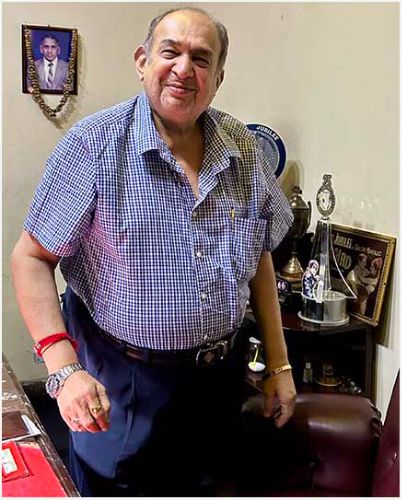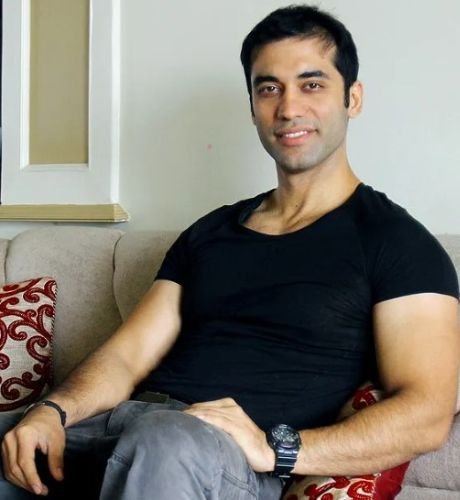This section is for paid subscribers only. Our subscription is only $3700/- for one full year.
You get unlimited access to all paid section and features on the website with this subscription.

Subscribe to read full article
This section is for paid subscribers only. Our subscription is only $37/- for one full year.
You get unlimited access to all paid section and features on the website with this subscription.
Not ready for a full subscription?
You can access this article for $2, and have it saved to your account for one year.
A reassuring landmark in erstwhile Bombay’s swiftly shifting landscape, to step into the grand, wood-panelled, mirror-embedded Art Deco interiors of Maratha Mandir, is to step well back in time. The man, who has been running the show since several decades, sits in his spacious office atop the stately curving staircase, adjoining the ‘balcony’ section of the movie theatre. Warm and ever-smiling, Manoj Desai, veteran film exhibitor, executive director of Maratha Mandir and the G7 multiplex, as well as producer of Khuda Gawah (1992), has lost none of his love for the movies. The challenges are many but so are the joys, he says, flanked by rows of trophies marking various jubilees of past hit films. The show must—and does—go on…
Proud child of freedom fighters
My family hails from Balsar. I am proud of my father Mohanlal Kikabai Desai and my mother Sarlaben Mohanlal Desai. They were freedom fighters working against the British for our country’s independence. As part of their freedom fight, they used to print anti-government posters and paste them on walls. Both got caught and were jailed in Indore; they were released in 1948. I was born to them shortly after the country’s independence in 1949. Later, we came to Bombay and my father went on to become a director in Khira Steel, while my mother was the vice principal of the Munshi Trust. I studied at Hansraj Morarji Public School, Munshi Campus, Andheri, followed by Bhavan’s College. However, I didn’t enjoy studying Science, especially when it came to dissecting a cockroach! I passed the year, and then switched to Arts at Chinnai College. Pankaj Udhas and I attended college together, we were very close. He used to love eating the food prepared by my mother at our house. Pankaj died recently and only I know how badly his passing has affected me.
Tryst with films
The year 1972 was when my journey in the film industry began; I had got married also at that time. I had completed my graduation in psychology and economics, and after that, was immediately appointed as manager at Gaiety-Galaxy theatres. Today, as executive director of G7 and Maratha Mandir theatres, among my other duties, I listen to suggestions by distributor and exhibitor Vinay Choksi of Om Enterprises, and I consult with my managing director Arun Nahar, before green-lighting the films that are screened in our theatres.
In the beginning, I didn't have any experience really as an exhibitor but I started learning slowly. Then I started utilising the people who were working, observing how they were functioning, etc. Watching films, of course, had always been a passion. I used to love films from the very beginning. When I was young, I used to bunk college with my friends and go watch the matinee shows of every film released.
I had entered with Gaiety-Galaxy and the first picture screened here was Seeta Aur Geeta (1972). There were only three theatres in this Bandra complex then - Gaiety, Galaxy and Gemini. Later, the multiplex scheme came in and now there are seven theatres, including Glamour, Gem, Gossip, and Grace in one building complex and that’s why it’s known as the G7 multiplex.
We acquired Maratha Mandir in 1979 when Mehtab Chand Golcha of Golcha Pvt Ltd. who had the theatre built, went under liquidation. We signed with the Maratha Mandir Trust, and took over the Maratha Mandir theatre on 3 November 1979.
Manmohan, my uncle
Manmohan Desai was my maternal uncle, and he was the cause of my interest in films. He made many super-hit films over the years. In time, when I produced Khuda Gawah (1992), I dedicated my film to my uncle. As the film starts, he says, ‘Action’, followed by a shot of the trophies, and then the game of Buzkashi, the national game of Afghanistan, begins with 600 horses.
Man-ji came for the private screening of the film and he praised it saying, “What a story Manoj has made! I am happy with Manoj.” He was very close to Amitabh Bachchan, and had made many successful films with him from Amar Akbar Anthony (1977), to Suhaag (1979), Naseeb (1981), Desh Premee (1982), and Coolie (1983). He always used to advise Bachchan to work with a good heroine like Sridevi, not an ‘altu-faltu’ one. During the interval, he went up to Jaya bhabi (Bachchan) and told her, ‘Now this is what you call a heroine! Your husband is a Pathan, and she matches him perfectly onscreen.’
Days of grand premieres
The theatre Maratha Mandir (designed by W M Namjoshi, who has a legacy of 33 single screen cinemas across India) was built in 1952. The capacity of the Maratha Mandir single screen theatre is 1,107 seats, including stall and balcony. The trustees of the Maratha Mandir Trust, who own the building, include Sharad Pawar, and the late Manohar Joshi and Rajmata Scindia. To my knowledge, the first picture screened at Maratha Mandir was the black and white film Sadhna (1958) by B R Chopra. The theatre came into the limelight with Mughal-e-Azam (1960), which ran here for 17 years, all paid shows. Later, I would also break its record by running DDLJ for 30 years. I was very young when Mughal-e-Azam released in 1960, but its premiere held at Maratha Mandir was beyond grand! Dilip Kumar came on horseback, Madhubala in a palkhi (palanquin). The entire industry was there.
The premiere of Khuda Gawah (1992), again at Maratha Mandir, remains so clear in my mind. Amitabh Bachchan, Mukul Anand (director) and I stood at the main gate receiving everyone. In fact, Amitji sat in this very room, my office, in my seat, as he gave an interview to BBC live telecast in London. The film was very well received. After the premiere, we went to the Leela Penta hotel at Andheri (East) where we hosted a party on the rooftop. The party went on till the wee hours of 3am…what a night!
A journey of 52 years
Previously, films came in large reels which would be transferred from one theatre to another. Now they come directly via satellite. It has become easier; that’s progress. Things are moving on … What is 52 years? It’s a lifetime, a journey from black and white to colour, to Dolby Digital Studio, with surround speakers placed left, centre, right, and behind to bring the full impact of action scenes, etc. Our theatres use the latest technology - our projector is brand new, our screens are brand new, the latest. We have had to deal with a lot of competition. Previously it was piracy and video. Now we have OTT. So, we have to remain very careful.
For the love of entertainment
We have been regularly updating and renovating our cinema halls. Frankly, while we don’t earn much we do earn enough. Compared to the multiplexes that earn in lakhs, I suppose we earn pennies. But we want all sections of audiences, including the lower middle class, middle class, and upper middle class to come here. We know all can't afford the Rs 500 and Rs 1,000 tickets of the multiplexes; their salaries cannot support these rates. Just take the rate of the samosas – our single screens as well as the multiplexes source the same samosas from Guru Kripa. But while we charge Rs 50 for two samosas, the multiplexes charge Rs 350 for the same samosas. We want our public to come here and enjoy themselves.
What today’s films lack
People want to forget their worries, their household problems. They want to be engrossed all through and when the picture ends and they come out, they want to be amazed that three hours have passed so quickly. This is what audiences want.
The passion and the patience required to make good cinema are lacking today. First of all, the producers should make good films. When I made Khuda Gawah (1992), we shot in Afghanistan, and in Pokhara and Jomsom in Nepal. We went there with the whole unit. But it was a successful movie, a super-hit film of Hindi cinema. Today's producers don't have enough patience and passion. They don't believe in a good story. They don't have good content. Filmmakers like Manmohan Desai, Prakash Mehra, Yash Chopra – they were complete entertainers. Their films worked so well. Now everyone wants to take their money and move on to the next project quickly. Even the distributors take their advance from us. We, the exhibitors, end up being the biggest sufferers because we bear the brunt when the film fails.
Helping single screens survive
OTT is also affecting us a lot. Some pictures are not super good, so people say, ‘Arre do mahine ke baad OTT mein aajaayega. Why go to the theatre?’ Even to get this two-month gap, we had to approach Sachivalay, have a talk with the minister.
As an exhibitor, I don’t get to see the film before I buy it but after 52 years in the business, one is able to guess the possible outcome of the film and decide accordingly. The year 2023 was a good year for us with super-hit films like Pathan, Jawan, Gaddar 2 – all big films. But 2024 has had no big movies so far. No pictures are running. So, this is not good for us.
Our main problem is that single screen theatres are not allowed to open advance booking early. Just a day or two earlier, they decide and allow us to go ahead. They want to get the multiplexes full first. My managing director, Arun Nahar doesn't believe in charging high rates for tickets. Our regular rate is Rs 110 and Rs 130.
The government should reduce the GST, which runs in crores. If they do that, we can further reduce our rates and the common public will benefit.
An international record
I have been screening DDLJ since the past 30 years at Maratha Mandir. But the Guinness Book of Records is sleeping and still hasn’t recorded our achievement. We crossed the records of all the films including that of Mughal-e-Azam (1960), which ran at our own Maratha Mandir for 17 years. It has already been featured in the Limca Book of Records but this is now an international record. We have already written to Guinness regarding the same.
The ticket rate to watch DDLJ is Rs 30 - Rs 40. Today, if you go to a restaurant and put a tip of Rs 30, you will be told, ‘Leke jao saab. Tees rupiya koi tip hota ha?’ We screen the movie with full air-conditioner. Even our canteen does very well. Everything is fresh and low-priced, and we are doing very well.
We screen entertainers, both Hindi and English, at our theatres. We get the most crowds on the weekend. On regular days we have around 40%-50% viewership, which goes to 60% if it’s a holiday. And DDLJ, every Saturday and Sunday runs full, till today. The audience is mixed; my own friends also come to watch. There is a Parsi lady Farzana who has watched DDLJ more than 600 times. She uses a wheelchair now but still comes twice a week.
There are people who have watched DDLJ 200, 250, even 300 times at Maratha Mandir. The cinema hall is very centrally located. A short walk from the Bombay Central station that faces the theatre, the ST terminus is behind us. Visitors to Mumbai, whether they come by train or bus, come here and enjoy a show of DDLJ. I have known couples who would come here during their dating days and they went on to get engaged and married. They come and tell me their stories. It makes me so happy.
Once I had been on a group tour with my family to Switzerland. Along with our fellow travellers, we were walking in the snow when we came upon a huge board informing that DDLJ was shot here. When some of our group members enquired about the reason behind the small smile on my face, I revealed to them that the sights we were currently seeing were part of DDLJ which had been running in our theatre Maratha Mandir for decades! All our fellow tourists were amazed and started clapping. They demanded to know why I hadn’t revealed my identity earlier; I told them it was entirely irrelevant to the tour and that we had all come to enjoy Switzerland!
Quelling rumours
Rumours do the rounds from time to time about us wanting to close down the theatre or sell it. There is no truth to these rumours. If I have to sell it, I will declare openly that I am selling it. We close the theatres for a few days whenever we are upgrading the technology or for maintenance such as rewiring, or changing the screen and projector. Recently, when Gaiety-Galaxy was shut for maintenance, the rumours of it being shut down again started doing the rounds. I did 18 interviews in one single day, clarifying the facts and putting the rumours to rest! We are running the theatre but if the film doesn’t run, what can we do?
A special bond
One star who is like family to me, comes to my home to eat Gujarati khaana, is Amitabh Bachchan. My house is just ten minutes away from his. I remember once he had come for the Satyanarayan puja at my house; it had created a huge jam in our area! Among the heroines, Sridevi remains my favourite. She was terrific, used to work so well. Her demise was very unfortunate.






.jpg)



